144″ vs 170″ Sprinter Van: Which Wheelbase is Best for Van Life?
Trying to decide between a 144” vs 170” Sprinter Van? Learn the pros and cons of each wheelbase for part-time or full-time van life.
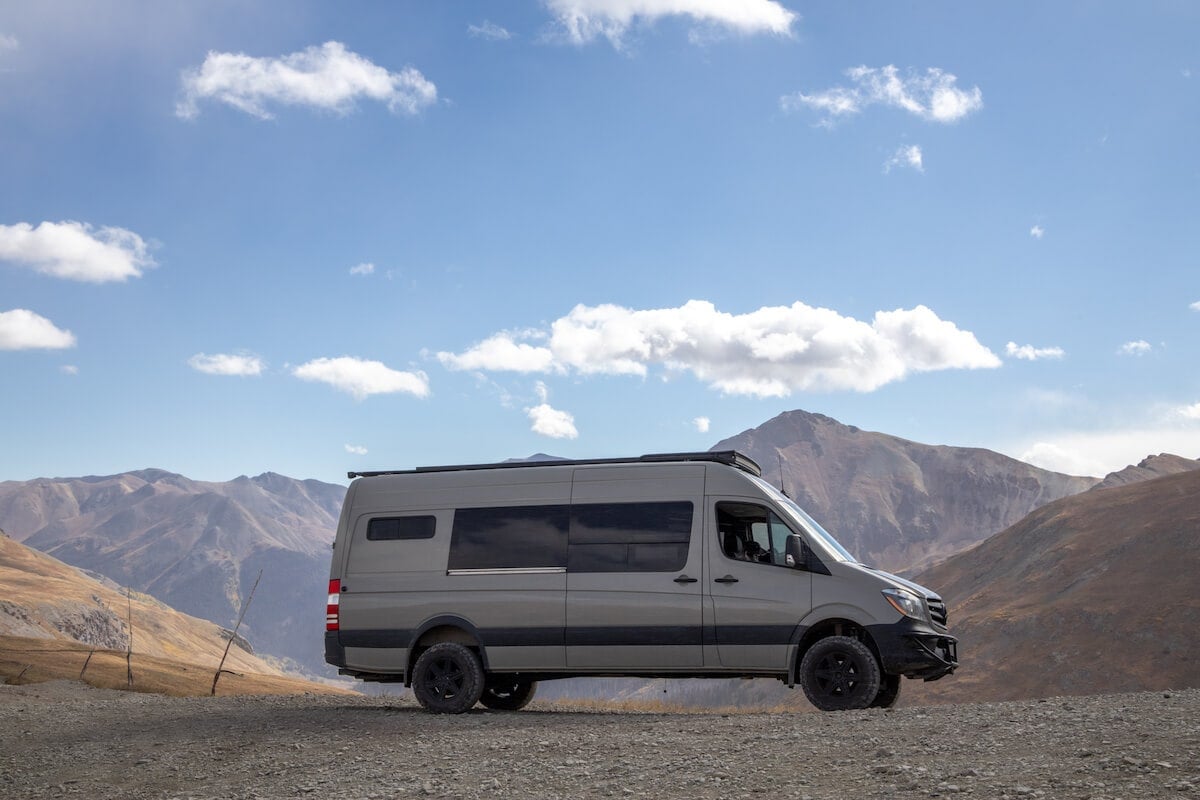
If you’re planning to buy a Sprinter Van to convert into a camper van, one of the first and most important decisions you have to make is which wheelbase you want. The Sprinter Van comes in three different wheelbases – a 144″ (the short wheelbase), a 170″ (the long wheelbase), and the 170-ext (the extra long wheelbase).
Which one you choose will affect how much storage and living space you have, the off-road capability, maneuverability in cities, parking, gas efficiency, and more.
Luckily I’ve owned both the 144″ and two different 170″ wheelbase Sprinter Vans, so everything I write here is based on my real-world experience.
My first Sprinter Van was a 144″ wheelbase, and I loved its maneuverability and how easy it was to park. I also craved a few more square feet to better accommodate my partner, our dogs, outdoor gear, and a full-time van living lifestyle. With that in mind, I sold my 144″ Sprinter and upgraded to the 170″, and I couldn’t be happier with my decision. Of course, a few sacrifices and challenges come with having a longer Sprinter Van but the extra space has been a worthy trade-off.
Read on to learn about the pros and cons of the 144″ vs 170″ Sprinter so you can decide which one is the best choice for your van conversion.
This post may contain affiliate links.
Sprinter Wheelbase Options & Dimensions
Wheelbase refers to the length of a vehicle between the front wheel axle and the rear wheel axle.
There are three different wheelbase options for Sprinter vans:
- 144″ wheelbase
- 170″ wheelbase
- 170″ extended wheelbase
144″ Wheelbase dimensions
The 144″ wheelbase is the shortest Sprinter van. It has the least amount of buildable space, but because it is shorter, it is easier to maneuver and park than the 170″ wheelbase.
- Full length from bumper to bumper: 19′ 6″
- Buildable space length: 11′
- Interior Height: High Roof Option = 6′ 7″ / Low Roof Option = 5′ 7″
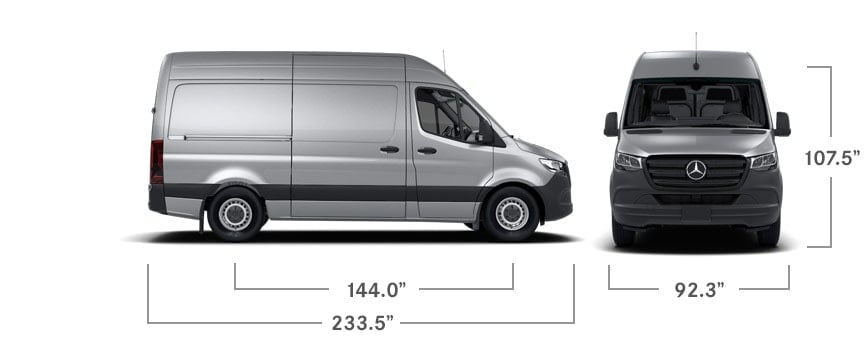
170″ wheelbase dimensions
The 170″ Sprinter wheelbase is what I have now. It provides just over three feet more interior space than the 144″ wheelbase while still being fairly easy to drive and park in normal parking spaces.
- Full length from bumper to bumper: 22′ 10″
- Buildable space length: 14′ 4″
- Interior Height: 6’7″ (170″ wheelbase only comes with the high roof option)

170″ extended wheelbase dimensions
The 170″ extended wheelbase Sprinter van is becoming a more popular choice for van lifers who want to maximize their living space and need more amenities while they travel. The extended chassis is about 1.5 feet longer than the regular 170″ wheelbase. While this provides additional living space, it does make maneuverability and parking more difficult. You’re also more likely to scrape the bottom of your van behind the rear wheel so you have to be more careful going over bumps or pulling into steep driveways.
- Full length from bumper to bumper: 24′
- Buildable space length: 15′ 9″
- Interior Height: 6′ 7″ (170″ ext. only comes with high roof option)

Save this post!
Enter your email & I'll send this post to your inbox! You'll also receive my weekly newsletter full of helpful advice for planning your adventures.
144 vs 170 Sprinter Van Comparisons
Sleeping
With a 144″ Sprinter van, you’ll have less total interior living space than with a 170″ or 170″ ext Sprinter van. If you have a 144″ Sprinter Van and plan to have a platform bed, the bed will take up a majority of the van’s living area, leaving little room for anything else besides a small galley as the bed will extend to the slider door. In a 170″, you can have a queen-sized bed installed and still have room for a galley and a small dinette or additional passenger seating.
One thing you can do to maximize the space in a 144 or even a 170″ Sprinter van is to install Flares. Flares bump out the side panels near the rear of the van so you can sleep sideways (wall to wall) instead of vertically down the length of the van. This can make a huge difference and give you almost two additional feet of usable space lengthwise in the van. I’d highly consider Flares if I were to build out another van especially now that my family has grown.
With Flares installed, the distance across the van will extend to up to 80″ (6’6″), so even very tall people can sleep in a sideways orientation. Flares come with or without windows so you don’t have to lose the view or ventilation from your bed.

One thing to note with Flares is because you gain back 20″ of living space, the area under your bed for gear storage, known as “the garage” becomes a bit shorter. For more pictures, check out the Flarespace Instagram page.

Bottom Line: A 144″ Sprinter Van can accommodate a queen-sized bed, but it will take up a majority of your living space. In a 170″, you can have a queen-sized bed and galley along with extra seating, storage or even a bathroom. Consider installing Flares if you want a shorter wheelbase but a more spacious living area.
Full-time Living & Storage
The most obvious difference between the 144″ vs 170″ Sprinter Van is that the bigger the van, the more living space you will have. The key is figuring out what you want in your van before you decide on the wheelbase. If you know you want a bathroom, a permanent platform bed, and seating for 4, you’re probably going to end up with the longer wheelbase. For tips on deciding on the right van layout, go here.
When I was in my 144” Sprinter, I traveled mostly solo, and for that it was perfect. I also didn’t have a bunch of bulky gear.
When I decided to upgrade to the 170″ wheelbase, I knew I would be living with my partner Ryan, our dog(s), two mountain bikes, and a bunch of other gear. I also knew I wanted a permanent bed vs one that converted from a dinette or a couch, like in my first van. As I sketched up floor plans, I couldn’t figure out how to make a permanent bed, a convenient workspace (which was a top priority), a decent-sized galley, and all of our gear fit in a 144” Sprinter.
Something would have to give if I decided to stick with a 144″ Sprinter. My workspace would have to double as the bed. Or the galley would be miniature. Or we’d have to leave the bikes at home.

Working with Outside Van, I came up with my ideal layout and a 170” it would have to be. You can take a full tour of my second (and third) 170″ Sprinter here. I can’t tell you how stoked I’ve been with that decision to go bigger. With the extra room Ryan, Charlie, Gumbo, and now my son and I have been able to travel in the van while maintaining our sanity.
With those few extra feet, we’ve been able to live fairly clutter-free. We also don’t have to move ten different things to the front seat every night or shuffle our stuff around to get to whatever we are looking for.
The extra space has also allowed me to have a permanent table to work on with all of my computer stuff stored right below. An efficient workspace is key when you are working with limited wi-fi and prefer not to spend your time poaching internet in towns and at McDonald’s.
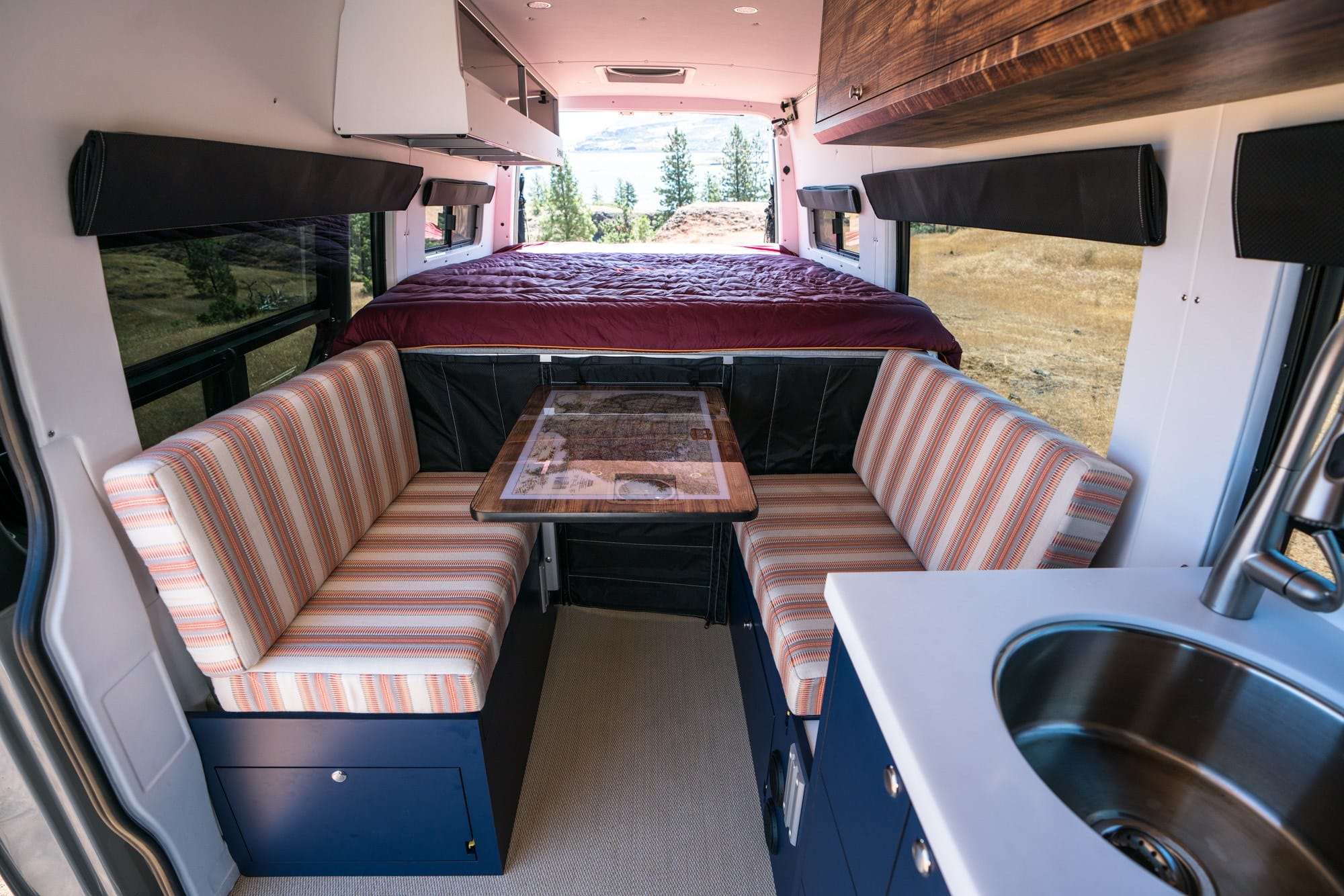
Now if I didn’t have to work on the road or we weren’t planning to travel for extended periods of time? I think we could have made the 144” wheelbase work, although I’m sure that van would still have been packed to the gills.
One other thing to keep in mind is the 144″ has a larger payload than the 170″ (when comparing the 2500 models). For 2022, the 144″ 4×4 Sprinter has a payload of 3,726 pounds, while the 170″ 4×4 Sprinter has a payload of 3,395 pounds. That means even though you have less space in the 144″, you can load it up with a few hundred more pounds.

Bottom Line: Think of how you will use the van. If you plan to take short weekend trips and are happy with a minimal build, the 144″ may suit you fine. If you plan to live in the van full-time or go on extended trips, have a bigger family (kids or pets), and simply want to spread out, the 170″ wheelbase or the 170″ ext is a great choice.
Parking & City Driving
One of the claims to fame for the 144” Sprinter Van is that it can fit in a normal parking spot – both length and width-wise. I’d agree that the 144” was a breeze to park, even in crowded parking lots and city streets. When I got my 144” Sprinter, I sold my Subaru, and my Sprinter became my daily driver for a year and a half. I loved driving it and felt like I could cruise down the road no differently than in my Subaru.
So how does the 170” compare to the 144″ in terms of parking? I’d say that the argument that the 170” Sprinter is a hassle to park is a bit overblown. Sure it’s longer….but if you pull all the way up to the curb until your front tires hit, the 170” can also “fit” in a normal parking spot. In really tight parking lots, you might have to park a little further out and walk an additional minute or two, but overall, parking the 170” Sprinter hasn’t caused me any more stress than parking my 144”.
I will say that a rear camera is absolutely necessary for the 170” Sprinter, especially if you don’t have rear windows, but I wouldn’t have wanted to go without a rearview camera in my 144” either.
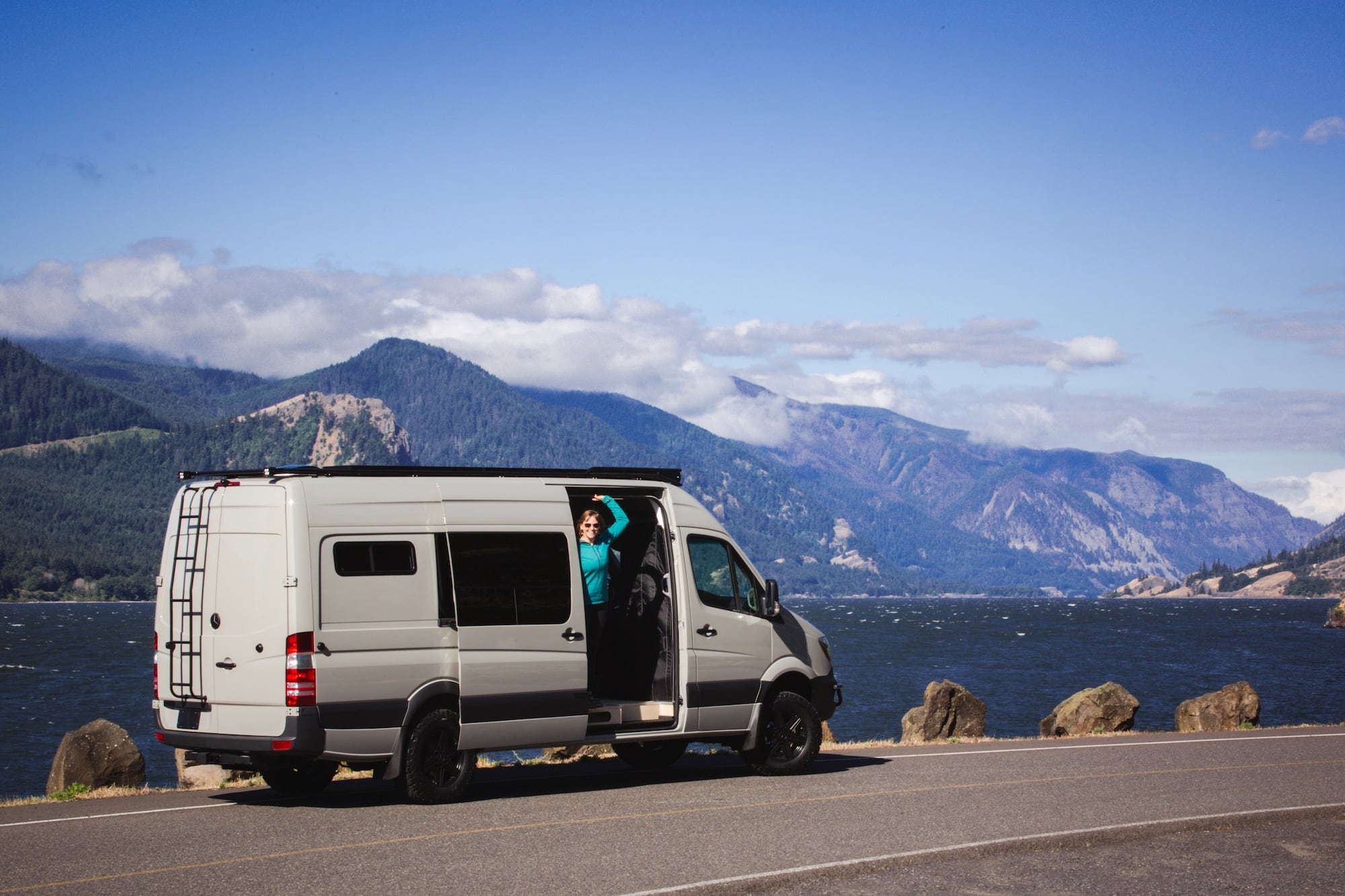
For city driving, both wheelbases handle nearly the same. The turning radius isn’t quite as good in the 170” vs 144” Sprinter, so you have to be a little more careful with U-Turns. Parallel parking is also a bit more challenging.
If you choose to go with a 170″ extended wheelbase Sprinter, keep in mind that this adds 1.5 feet to the van, making it more difficult to park in normal parking spaces and navigate in busy areas. Also, if you plan on stealth camping, a 170″ ext will likely draw more attention as it is more obvious it’s a camper.

Bottom Line: This comes down to how much time you plan to be in cities vs rural areas. If you live in a busy city and frequently park in busy areas, the 144″ will be easier to drive and park. If you are like me and you try to avoid big cities, then the 170″ wheelbase shouldn’t be an issue.
Off-Road Driving
Let’s be honest. Neither Sprinter wheelbase is going to be as off-road friendly as a Jeep or lifted pickup truck. However, either Sprinter Van wheelbase with the 4×4 option is going to be a surprisingly capable vehicle, with the 144″ having an obvious advantage. The 170″, while not quite as nimble, is still a beast, and the 170″ extended Sprinter would be the clear loser in terms of off-road capability.
The first benefit of the 144″ Sprinter for off-road driving is the turning radius. If you find yourself in a pickle and need to turn around, you’ll have an easier time in the 144″ vs the 170″ Sprinter. A 144″ can also handle steep switchbacks more easily.
The second advantage is the 144″ wheelbase is more nimble. Because of the shorter wheelbase, you’ll be less likely to scrape the bottom if the terrain gets unexpectedly gnarly.
Does that mean that you can’t off-road in the 170″ wheelbase? Absolutely not! We’ve literally explored thousands of miles of rough dirt roads and camped at many remote dispersed campsites in my 4×4 170″ Sprinter.
We’ve even driven our 170″ Sprinter over Cinnamon Pass and Stony Pass in Colorado where the only other vehicles we saw were Jeeps and ATVs. Now I’m not saying I’d recommend taking your Sprinter on these roads unless you are a very confident off-road driver, but I’m sharing to prove that with the right driving skills either wheelbase is capable of exploring and getting far off the grid.
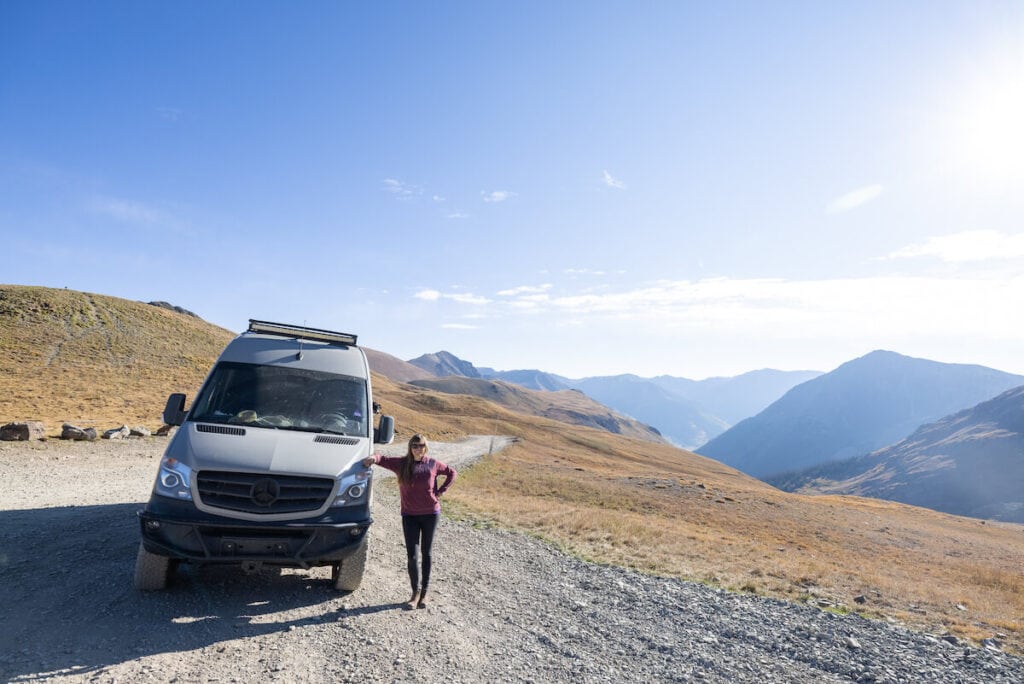
There has only been one time where we ran into an issue with our 170″ Sprinter and that was driving over Ophir Pass in Colorado. We encountered a section where there had been a recent shale slide and there were deep ruts in the road. We tried to drive through them and couldn’t get up and over the ruts. The road was too narrow to turn around, so we ended up having to back down the road several miles with a steep drop-off on one side of the van. I’m not sure if a 144″ would have made it either, but a 144″ may have been able to turn around sooner. And honestly going up there in the first place was probably a bad decision.
I’ll also mention that the quality of your conversion makes a difference in the off-road capability of your Sprinter Van. Using durable materials that can withstand the vibrations of dirt roads and having a low center of gravity will enhance your vehicle’s off-road performance. A well-built 170″ Sprinter Van will be more off-road capable than a poorly built 144″ Sprinter Van. Upgraded suspension, which we have on our van, also makes a huge difference.

Bottom Line: If you know you want to rally your Sprinter to its limits, you’ll have more wiggle room with the 144”. But the 170” wheelbase with upgraded suspension and a solid interior will still take you off the beaten path as well.
Gas Efficiency
If you’re comparing empty vehicles, the 144″ will slightly outperform the 170″. However, once you load them up with weight and hang a bunch of stuff on the outside, your gas efficiency in either wheelbase will be affected.
In my first Sprinter Van, I had a beefy roof rack, a ladder on the side, and a big Aluminess bumper with a spare tire and box on the back. That van was also built with really heavy materials, such as tile, reclaimed barnwood etc. In that van I was averaging 12-14 mpg.
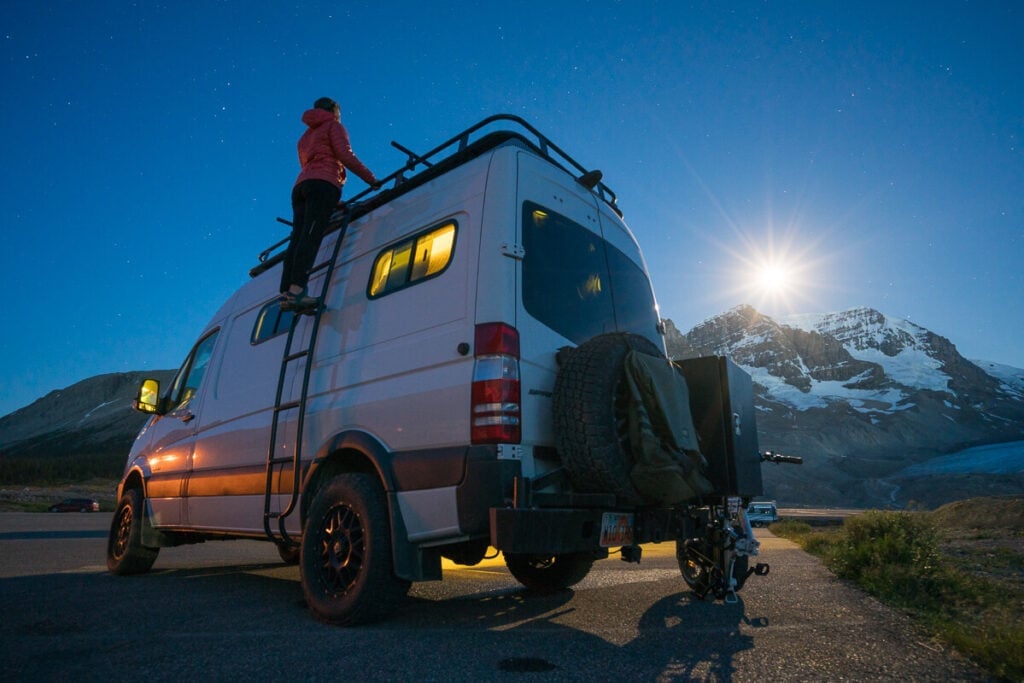
In my 170″ Sprinter I wanted to keep the build streamlined with everything inside the van. My roof rack is lower profile, and I don’t have any extraneous accessories on the outside. Outside Van (my conversion company) also worked to keep my build as light as possible. I was surprised to find out that my 170″ actually got better gas mileage than my 144″, average 13-16 mpg.

Bottom Line: Gas efficiency between the 144″ vs 170″ Sprinter is pretty similar. Exterior accessories and overall weight play a bigger role than the differences between the wheelbases.
If you are trying to decide between a 144″ vs 170” Sprinter Van, I hope this blog post and my experience helps you weigh your options. For more inspiration for your build, check out all of my Sprinter Van content here.
What other questions do you have about the 144″ vs 170″ Sprinter van? Which wheelbase size are you thinking or did you go with, and what has been your experience? Let us know in the comments!

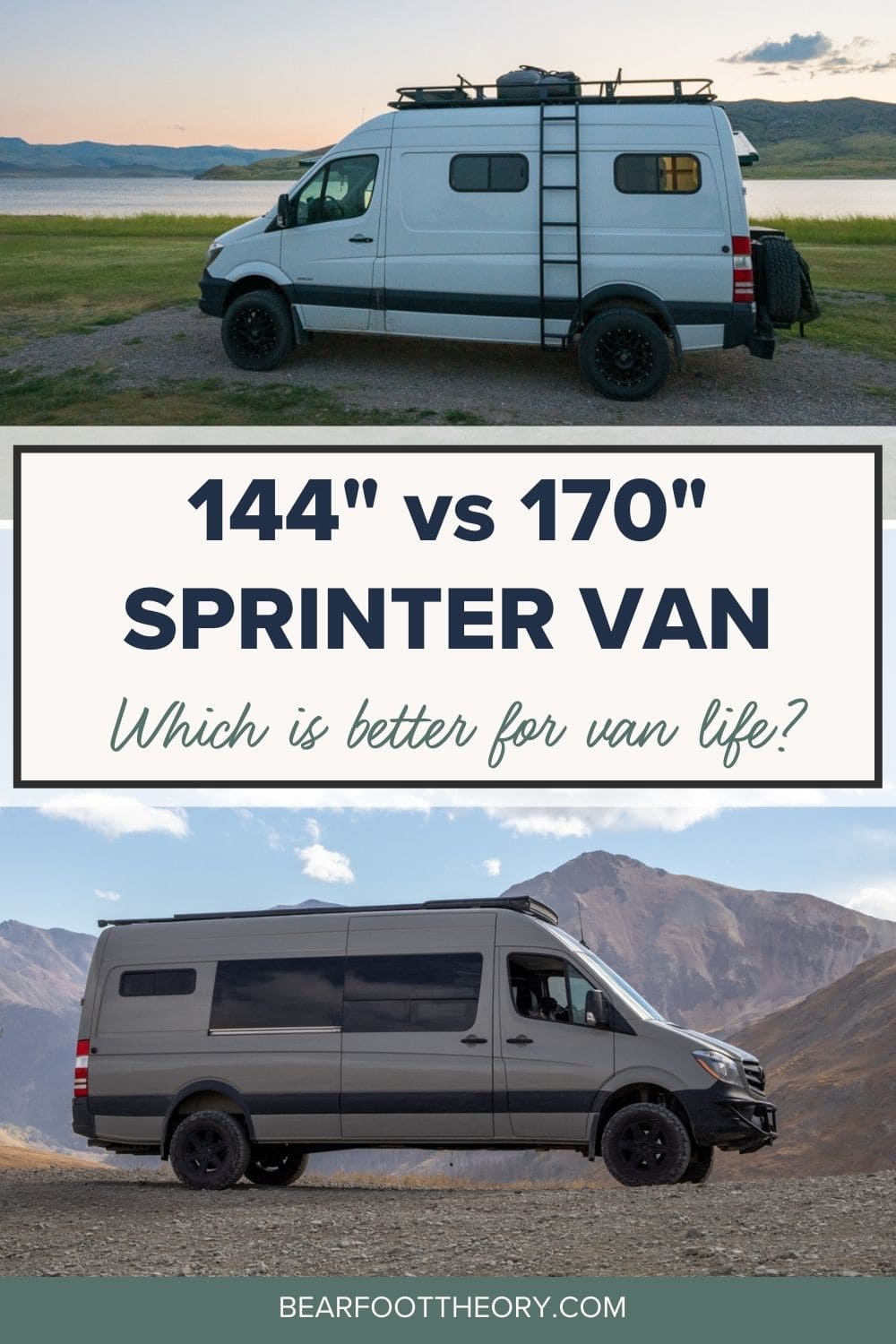
I’ve been going back and forth between wanting the 144 or 170”. It was great to hear the perspective of someone who has experienced both. Thanks!
Glad we could be of support, Ali! Best wishes on your own van!
Thanks! It is extremely helpful to have feedback from someone who has done both wheelbase lengths!
I was indeed surprised by the MPG you reported! Did you happen to have any info from before you had the buildout completed? (I’m curious how much weight effects MPG vs driving style).
As I’m traveling solo and will be using the van as a daily driver while still working in and around cities, I think I’m still leaning towards the 144” but I feel more comfortable going 170” if that option becomes available significantly sooner!
Thanks again!
Hey Mitch – I didn’t drive the 170 before the conversion happened, since Outside Van got the van straight from the dealer. I think if you’re solo the 144 is perfect…but it really depends on your layout and what gear you want in the van.
Hi Kristen,
Thank you for this article. I didn’t realise that Sprinters came in 4×4, but maybe that’s an Australian thing. My partner and I have been tossing around this conundrum as well. The 144s in Australia are the basis of our ambulance fleet so there are many preloves out there as a reasonable price. Basically you have talked me into pushing for the 170 as we have 2 40kg/80lb+ dogs that like kids have to be separated while travelling. At present our ride is a just adequate Citroën Berlingo van. But I wouldn’t want to be living out of it.
Anyway thanks for your blog.
Have you ever had to deal w mold? My crew van has water on the windows on the inside and a green mold formed on my basket.
No, I haven’t had an issue with mold. I try to sleep with a window cracked or the van on to prevent that issue…especially if the heat is on.
That’s awesome to know about the gas mileage!!! Thanks for this great post!
According to the van size images you have shared the high roof doesn’t affect the final exterior high of the van. The 3 vans are all around 107″. Is that correct?
Hi Andres, we only shared images of the high roof Sprinters since a low roof isn’t super common for van life. For the 2021 Sprinter 144″ wheelbase low roof cargo van, the exterior height is 96.3 inches.
You’re focusing on Sprinter, but Promaster also has a goldilocks option with the 159. or 159ext which is basically the same as Sprinter 170. No 4×4 though but I think Transit offers that.
I guess I jumped the gun and asked a question of the 144 vs 170 drivability. Thank you for this post it does seem there’s not a whole lot of sacrifice to drivability with the 170.
Hi! Can you still fit a 6′ bed behind the second row of seats in the 144?
thank you =, your article was very helpful. have a great 170 now, was considering 144, but maybe not with all the great features you pointed out
Thanks so much for this post!
Thank you so much for the priceless information. Your knowledge and experience will definitely be helpful.
Glad you found it helpful! Thanks for reading 🙂
Hi Kristen, I’ve recently found your blog, thank you for all your informative and helpful posts!
I have converted a Dacia Dokker, akin to a VW Caddy, to a mini camper with Youtuber René Kreher as my primary inspiration. I’m thinking about building myself a much larger camper. It needs to sleep three people, two adults and a child. A 170 vs a 144 might just make the difference between my plans being realistic or not.
I was wondering, do you perhaps have a floor plan of your 170″ Sprinter? I’d love to see what (approximate) dimensions you used, especially for the bed, the galley and the dinette. Also, I’m interested in the height of the bed.
Thank you for all your efforts!
Hi Rainer, so glad you found us and that you’re finding our resources helpful! Unfortunately, we don’t have a floor plan of Kristen’s 170″ Sprinter. It was built by Outside Van and you’ll find all the information that’s available here on our site. If you haven’t already, check out the full article and video van tour: https://bearfoottheory.com/outside-van-sprinter-conversion-tour/
Thank you for the article! Can I ask what you use for internet?
Hi Paula Lee – we have a blog post all about that! https://bearfoottheory.com/van-life-internet-access/
Hi Kristen,
Great website with tons of good information. I cannot tell from your description if you own the diesel or gas powered model. Is yours a diesel engine? We are considering getting a diesel Sprinter conversion van and wondered if you can describe the overall road performance of your van. What is its approximate GVW and HP rating? Would you say your van is peppy on the road or is it more snail like? We don’t want to become the slow poke motorhome driver who is holding back traffic on a long hill. Thanks for your advice and comments.
Ed
Hi, just checking, you have the 170 4×4 with single rear wheels, meaning the 2500 engine?…I’m concerned with the weight of the build out that the 3500xd is a better option, but the 3500vd is a dually…any thoughts on dually vs single rears? Thanks
So helpful. We’re waiting for our 22′ 2021 Coachman Beyond 22D. We chose the dinette rear because I also need a traveling office…and might have to take clients (if Covid is every over). Also, my husband and I have been married for 32 years and I wanted to keep it that way. ha-ha. He can use the front swivel chairs and table, and I can use the back space and we both have a place to work or relax with some privacy…I think a curtain may even be helpful. Your discussion of the longer wheelbase vs. shorter really confirmed our choice to go longer. You really covered all the areas we were most curious about. Everyone has to take their own needs/wants and aspiration when choosing, but I think our decision to go longer is a good one. Thanks for your very thorough and thoughtful comparison. Rock on!
Glad you found this post helpful, Sharon. Happy travels!
Your posts have been so helpful. Does your new 170 van have a bathroom? It doesn’t look like it from the photos.
Thanks for reading, Linda! Our new van does not have a bathroom. If you’re interested in reading more about why, we have a post on the Pros and Cons of van bathrooms and 7 Reasons You Don’t Need a Van Shower.
Hi!
Did you choose not to do a inside shower? And if so why?
Thanks!
Jason Russell
Hi Jason, I had an indoor shower in my first van, but I decided to leave the shower out when designing my second van. You can read more about why in this post.
My late husband and I dreamed of traveling…I am looking at this becoming reality..solo..any advice?
Hi Tracy – we have a whole post on Solo Van Travel!
Great blog. My big concern with Sprinters is reliability and getting them serviced when needed. If not for that possible problem they would be an obvious first choice. Can you speak to that or do you have a blog that does?
I couldn’t agree more with this blog on 144 vs 170 Sprinters. I purchased a 2019 Sprinter 2500 crew van with a 144 WB a little over a year ago and converted it to a camper. I want thru lots of possible floor plans and ended up without a shower. My wife agreed to this on the condition that we stop somewhere (usually a hotel) for a hot shower every 3 days or so. For occasional trips I really like the maneuverability of the 144″ wheel base. If I were a full time van lifer it would be a bit cramped for sure. I guess MB had improved the mileage as I got close to 20 mpg on a recent trip between Raleigh NC and Salt Lake City; my van has the diesel engine and isn’t a 4×4.
Keep up the good work.
I’ve been scouring the web for days looking for good opinions on this subject and your post is perfect. Thank you!
Hi Ian, glad to hear that! Good luck with your research
VERY helpful; grateful for your sharing. We are NOT going to live full time in the Transit AWD van we plan to build soon. We are in our late 70s age. We live in East but plan to make some 1 month trips to the West to revisit natural areas & seashores we spent our professional lives working to protect with national legislation. So we plan to use a lot of USFS, NPS & BLM dirt & gravel roads. We don’t want to unintentionally get in situations where a Transit Extended Length might drag tail or be impossible to turn around. So we’re trying to see if our bed & accessibility needs can be met in standard body length 148″ Transit. Any thoughts?
Hi Terry, so neat to revisit places that you worked on protecting during your careers – thanks for sharing your van plans! For what it’s worth, I recently built out my third Sprinter van and once again chose the 170″ length. Since we spent so much time out in nature and away from cities, I really don’t think the added length makes a huge difference in terms of maneuverability and I still prefer having the added interior space of the 170″. Unless you plan to go serious off-roading, there should be very few times – even on USFS, NPS, & BLM dirt roads – that you run into a situation where the added length would be a huge hassle compared if a shorter wheelbase. I hope this helps – and enjoy your travels 🙂
Thank you Kristen, for the helpful info!
Trying to decide between a 144 and 170. I was curious about your gas mileage. We had an older 170 diesel and averaged 20mpg, up to 25mpg for a couple of trips and no less than 18mpg towing a trailer with our side by side. Was your 144 AWD? Gas or diesel?
Thanks again!
All of my vans have been 4×4, and I haven’t noticed a major difference between the 144 and the 170. My second van which was the lightest and was a 170″ actually got the best gas mileage by a small margin.
Hey Kristen,
Great article. Thank you. I am a bit late reading it, since I am about to pick my 144 this weekend. Very excited about it. Never rv’ed before. It may be a silly question, but could you guide newbies like me the best app for rving, boondocking. And could you give some recommendations how to make as little rattling as possible in the RV while driving, like what kind/brand drawer organizers, how to secure certain things etc. Thanks in advance.
Hi! Congrats on your van. Here are two posts you should check out:
https://bearfoottheory.com/ultimate-guide-finding-free-campsites/
https://bearfoottheory.com/camper-van-organization-ideas/
Thank you so much for sharing this! Great information. I had a 170 extended, strictly cargo for my business and I loved it! I loved driving that van, even if I didn’t need to. I moved to Wyoming a few months ago and couldn’t take my car and the van too so I had to sell it. Now, I’m looking for another van. There were times in Texas that the wind became dangerous and the wind here gets out of control. Was wondering if you noticed the 144 or the 170 to be better in windy conditions? Maybe being loaded all the time made a difference.
Thank you again!
The best thing you can do for dealing with windy conditions is going to be to upgrade the suspension. Agile Offroad and Van Compass are the two companies I’d recommend you check out.
Hi Kristen:
Thank you for sharing your insightful experiences in relation to the Sprinter Vans. What you’ve shared has helped me to make a well informed purchase. I’m going into retirement and have been considering a Sprinter van purchase for some time, but never had enough user friendly information to fuel my decision. Thanks to your blog, I’m certain that the 170″ wheel base is what I’m going to go with.
Thanks again.